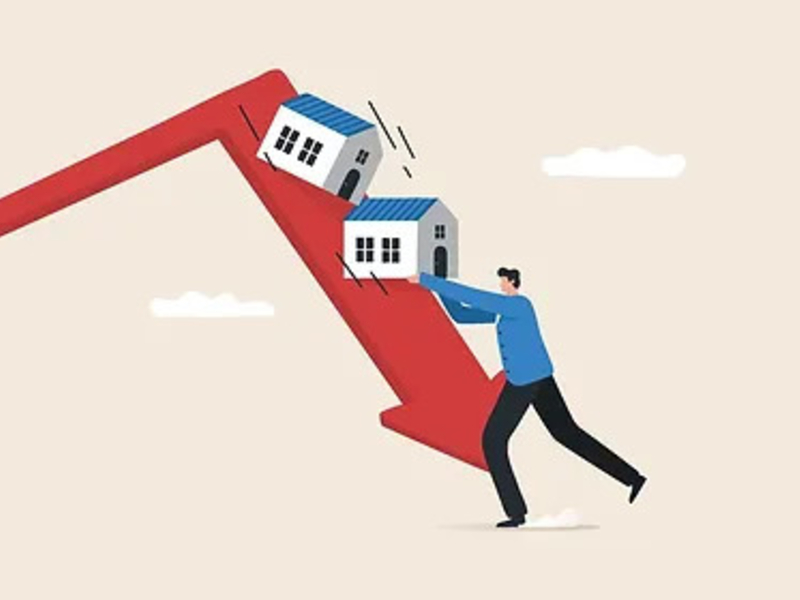The threat of a broader trade war looms over the global markets. As global economic tensions rise and talks of renewed tariffs dominate headlines, the U.S. real estate market also finds itself in the crosshairs.
Whether it’s residential real estate or commercial development, the impact of tariffs and the potential threat of a trade war is becoming harder to overlook.
The Impact of Tariffs on US Real Estate-
- Rising Construction Costs: Tariffs on key imported materials, like steel, aluminum, lumber, and copper, are significantly increasing the cost of construction and renovations across the U.S. real estate market. According to the National Association of Home Builders, these tariffs could tack on an extra $7,500 to $10,000 to the price of building a single-family home. The buyers are picking the tab. This is hitting especially hard in a market already battling affordability issues and limited inventory. Materials Most Affected: Lumber (with 30% of U.S. demand met through imports), Steel, Aluminum, Stone, Copper, Glass, Fixtures. The impact of this would be higher home prices, smaller square footage, and steeper renovation costs.
- Project Delays and Cancellations: With material prices fluctuating and supply chains under pressure, developers are struggling to keep projects on budget. Many are left with no choice but to delay or even cancel new builds- especially those with razor-thin margins. The result? Even fewer homes entering an already tight housing market.
- Ongoing Supply Chain Disruptions: Trade tensions, especially those with major material suppliers like China and Canada, are throwing a wrench into U.S. construction timelines. When essential materials are delayed or become too expensive, developers face a tough choice: push back project timelines or raise prices for buyers and renters. This is particularly concerning in fast-growing markets like Texas, Florida, and California, where housing and commercial developments are already racing to keep up with demand.
- Housing Affordability Crisis: Since December 2020, construction material costs have skyrocketed (up 34%), far outpacing inflation in other sectors. This spike is driving up home prices and rental rates, making it tougher for Americans to find affordable places to live.
- Mortgage Rate Volatility: Trade tensions are also shaking up the mortgage market. While some tariff announcements initially cause rates to dip due to market jitters, the broader trend is climbing. If inflation sticks around and uncertainty continues, experts warn mortgage rates could soar to 10%, putting homeownership even further out of reach for many.
- Impact on Commercial Real Estate Investments: Trade wars don’t just raise costs—they shake investor confidence. Foreign investors, already cautious amid geopolitical uncertainty, may scale back on U.S. real estate. That’s bad news for the commercial real estate sector, which relies heavily on global capital and foreign direct investment.
- Real Estate Financing & Interest Rate Concerns: Trade wars often trigger economic ripple effects, prompting central banks to adjust interest rates in response to inflation or currency fluctuations. In the world of real estate, these shifts carry two major consequences:
- Higher Borrowing Costs: As interest rates climb, loans become more expensive for both developers and homebuyers. This can slow down new projects and reduce access to financing, especially for those already working within tight budgets.
- Rising Rents Fueled by Inflation: Landlords may raise rents to offset higher operating and financing costs. This hits lower-income renters the hardest, increasing vacancy risks in vulnerable housing segments.
- Housing Market Sentiment: Consumer confidence is a cornerstone of the housing market. When homebuyers sense economic instability, they often take a step back. Whether it’s delaying a mortgage application or putting off plans to buy a second home, uncertainty leads to hesitation. According to Fannie Mae’s Home Purchase Sentiment Index, geopolitical and trade-related concerns rank among the top reasons potential buyers choose to wait.
How trade uncertainty affects CRE:
- Market Volatility: Trade tensions can trigger fluctuations in REITs and commercial real estate stocks.
- Cap Rate Pressure: Higher construction costs and lower demand from investors can push up cap rates, reducing overall property values in key sectors like industrial and multifamily.
- Less Demand for Industrial Space: Tariffs often slow down international manufacturing and shipping, leading to decreased demand for logistics hubs and warehouses, especially near major ports.
Regional Impacts-
Some cities and sectors are more directly exposed due to their reliance on global trade or specific economic drivers.
- Port Cities (e.g., Los Angeles, Seattle, Savannah): These areas are closely tied to international trade and are highly sensitive to supply chain disruptions and import/export slowdowns.
- Manufacturing Hubs (e.g., Detroit, Houston): Trade barriers can hurt local industries, reduce demand for exports, and stall industrial growth.
- Border States (e.g., Texas, Arizona): With strong economic ties to Mexico and Canada, these states are particularly impacted by shifts in trade policy under agreements like USMCA.
Sector-Specific Effects of Tariffs and Trade War-
Let us now discuss how the potential trade war might be a bane? Or a boon for specific sectors-
Residential Real Estate
- Higher home prices due to increased construction costs
- Reduced housing affordability for buyers and renters
- Project delays and cancellations, further limiting housing supply
Commercial Real Estate
- Increased costs for new developments and renovations
- Lower property values as cap rates expand
- Higher rents as landlords pass on increased expenses to tenants
Industrial Real Estate
- Supply chain disruptions affecting construction and operations
- Increased demand for domestic warehousing as companies seek to localize supply chains
- Potential shifts in tenant mix and location preferences
Retail Real Estate
- Higher costs for imported goods impacting retailers’ profitability
- Reduced consumer spending due to higher prices
- Store closures or downsizing as retailers adjust to new economic realities
Long-Term Outlook-
While short-term market turbulence is expected, the long-term effects of tariffs and trade wars will depend on how prolonged and severe the conflict becomes. If tensions escalate, the real estate landscape could see some major shifts:
- Supply Chain Redesign: A full-scale trade war may push companies to rethink their global supply chains, leading to more localized production. That shift could eventually boost demand for industrial real estate in the U.S.
- Rise in Reshoring and Onshoring: More companies may move manufacturing back to the U.S., fueling demand for logistics hubs, warehousing, and industrial campuses, especially near transportation corridors.
- Persistent Price Pressures: If material and labor costs continue to rise, and new construction fails to catch up, expect higher home prices and rental rates for the foreseeable future.
The U.S. real estate market (both residential and commercial) is more connected to global trade policy than many realize. As tariff tensions rise and trade disputes deepen, the ripple effects are being felt everywhere, from construction sites to investment portfolios.
Whether you're a developer, investor, or first-time homebuyer, staying informed on trade policy isn't optional: it's essential. Rising costs, delayed projects, and shifting investor behavior can directly impact property values, financing options, and long-term returns on investment.
Trending





